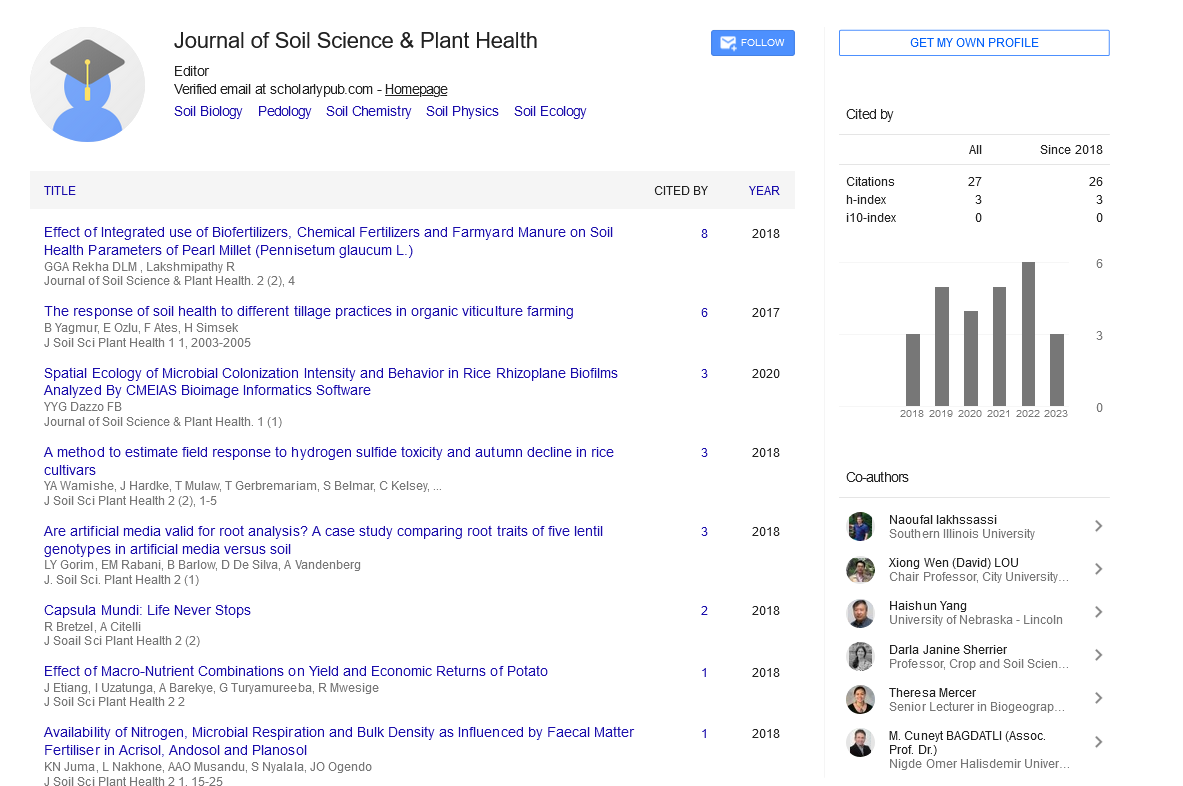Editorial, J Soil Sci Plant Health Vol: -7 Issue: -1
Biofertilizers: A Sustainable Solution for Soil Fertility and Crop Productivity
Wai Kwong*
Department of Microbial Ecology, Shanghai Jiao Tong University, China
- *Corresponding Author:
- Wai Kwong
Department of Microbial Ecology, Shanghai Jiao Tong University, China
E-mail: wai559@gmail.cn
Received: 01-Feb-2025, Manuscript No. Jsph-25-170160; Editor assigned: 4-Feb-2025, Pre-QC No. Jsph-25-170160 (PQ); Reviewed: 18-Feb-2025, QC No. Jsph-25-170160; Revised: 25-Feb-2025, Manuscript No. Jsph-25- 170160 (R); Published: 28-Feb-2025, DOI: 10.4172/jsph.1000205
Citation: Wai K (2025) Biofertilizers: A Sustainable Solution for Soil Fertility and Crop Productivity. J Soil Sci Plant Health 7: 205
Introduction
Biofertilizers are natural substances containing living microorganisms that promote plant growth by increasing the availability of essential nutrients to plants. Unlike chemical fertilizers, which supply nutrients directly but can harm the environment, biofertilizers enhance nutrient uptake through biological processes [1]. These eco-friendly alternatives are gaining attention worldwide as a key component of sustainable agriculture, helping to improve soil health, reduce chemical dependency, and increase crop yields in a safe and cost-effective manner [2].
Discussion
Biofertilizers work by colonizing the plant rhizosphere—the soil region close to plant roots—and facilitating nutrient acquisition. They contain beneficial microbes such as bacteria, fungi, and cyanobacteria that perform crucial functions like nitrogen fixation, phosphorus solubilization, and production of growth-promoting substances [3].
One of the most common types of biofertilizers involves nitrogen-fixing bacteria. For instance, Rhizobium species form symbiotic relationships with legume roots, converting atmospheric nitrogen into ammonia that plants can absorb. Similarly, free-living nitrogen fixers like Azotobacter and Azospirillum fix nitrogen independently in the soil, enriching it naturally and reducing the need for synthetic nitrogen fertilizers [4].
Phosphorus is another vital nutrient often locked in insoluble forms in the soil. Phosphate-solubilizing bacteria (PSB) and fungi release organic acids that convert unavailable phosphorus into forms accessible to plants, improving growth and yield. Additionally, mycorrhizal fungi form mutualistic associations with plant roots, extending the root system and enhancing the uptake of phosphorus, water, and other micronutrients [5].
Biofertilizers also contribute to improved soil structure and fertility by increasing organic matter content and stimulating microbial activity. Some microbes produce plant hormones such as auxins and cytokinins, which promote root growth and enhance plant vigor. Moreover, certain biofertilizers help plants resist diseases by suppressing harmful pathogens or inducing systemic resistance.
Despite their benefits, biofertilizers’ effectiveness can vary due to factors like soil type, climate, crop species, and microbial strain compatibility. Unlike chemical fertilizers, biofertilizers work gradually and rely on the survival and activity of microorganisms, which require proper storage and handling. To maximize their potential, farmers must be educated about their application methods and integrated use within a broader nutrient management system.
Recent advances in biotechnology have enabled the development of more efficient biofertilizer formulations, including microbial consortia that combine multiple beneficial species. These formulations enhance nutrient availability and plant growth more effectively by exploiting synergistic interactions. Governments and agricultural organizations worldwide are promoting biofertilizers as part of integrated soil fertility management strategies to achieve sustainable crop production while minimizing environmental impacts.
Conclusion
Biofertilizers offer a promising and environmentally friendly approach to improving soil fertility and crop productivity. By harnessing the natural abilities of beneficial microorganisms, they reduce dependency on chemical fertilizers, promote healthier soils, and contribute to sustainable agriculture. While challenges remain in ensuring consistent performance and farmer adoption, ongoing research and extension services are paving the way for wider acceptance. Integrating biofertilizers into modern farming practices is essential to building resilient agroecosystems and ensuring food security in an ecologically responsible manner.
References
- Löther, A, and Maurer, E. (2008). â??Evaluation of Gender Equality Policies.â? Gender Equality Programs in Higher Education, 53â??67.
- Neigh G (2008). â??The promotion of sexual equality and non-discrimination in the workplace: A Nigerian perspective.â? 13 (4): 56-59.
- Grace S, Higgs J (2010). Integrative medicine: enhancing quality in primary health care. J Altern Complement Med. 16: 945â??950.
- Rihtaric D, Hostnik P, Steyer A, Grom J, Toplak I, et al (2010). Identification of SARS-like coronaviruses in horseshoe bats (Rhinolophus hipposideros) in Slovenia. Arch Virol. 155: 507-514.
- Tao Y, Tong S (2019). Complete genome sequence of a severe acute respiratory syndrome-related coronavirus from Kenyan bats. Microbiol Resour Announc. 8: 00548-19.
Indexed at, Google scholar, Cross ref
Indexed at, Google scholar, Cross ref
 Spanish
Spanish  Chinese
Chinese  Russian
Russian  German
German  French
French  Japanese
Japanese  Portuguese
Portuguese  Hindi
Hindi 